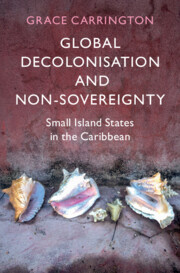Refine search
Actions for selected content:
615759 results in History
Figures
-
- Book:
- My Own Past
- Published online:
- 30 September 2025
- Print publication:
- 18 September 2025, pp xv-xxii
-
- Chapter
- Export citation
Note on the Text
-
- Book:
- Latin America and Human Rights Politics in West Germany, 1973–1990
- Published online:
- 18 October 2025
- Print publication:
- 18 September 2025, pp xiii-xiii
-
- Chapter
- Export citation
1 - Antifascism
-
- Book:
- Latin America and Human Rights Politics in West Germany, 1973–1990
- Published online:
- 18 October 2025
- Print publication:
- 18 September 2025, pp 24-68
-
- Chapter
- Export citation
Chapter Two - Afrodescendant Artists and Citizenship: The Twentieth Century
- from Part I - Artists of African Descent and Cuban Art through the 1930s
-
-
- Book:
- My Own Past
- Published online:
- 30 September 2025
- Print publication:
- 18 September 2025, pp 23-81
-
- Chapter
- Export citation
Bibliography
-
- Book:
- Latin America and Human Rights Politics in West Germany, 1973–1990
- Published online:
- 18 October 2025
- Print publication:
- 18 September 2025, pp 323-347
-
- Chapter
- Export citation
Copyright page
-
- Book:
- The Making of Revolutionary Feminism in El Salvador
- Published online:
- 28 October 2025
- Print publication:
- 18 September 2025, pp iv-iv
-
- Chapter
- Export citation
Introduction
-
- Book:
- The Making of Revolutionary Feminism in El Salvador
- Published online:
- 28 October 2025
- Print publication:
- 18 September 2025, pp 1-51
-
- Chapter
- Export citation
The roots of inequality: California agriculture and the seeding of Silicon Valley’s technology economy, 1935–1965
-
- Journal:
- Urban History , First View
- Published online by Cambridge University Press:
- 18 September 2025, pp. 1-30
-
- Article
-
- You have access
- Open access
- HTML
- Export citation
Chapter Five - Against Antiblack Racism
- from Part II - The Art of Afro-Cubans since the 1930s: Statements on the Social Condition and Cultural Heritage
-
-
- Book:
- My Own Past
- Published online:
- 30 September 2025
- Print publication:
- 18 September 2025, pp 125-179
-
- Chapter
- Export citation
5 - Politics of Revolution
-
- Book:
- Latin America and Human Rights Politics in West Germany, 1973–1990
- Published online:
- 18 October 2025
- Print publication:
- 18 September 2025, pp 183-222
-
- Chapter
- Export citation
Part I - Artists of African Descent and Cuban Art through the 1930s
-
- Book:
- My Own Past
- Published online:
- 30 September 2025
- Print publication:
- 18 September 2025, pp 1-86
-
- Chapter
- Export citation
Copyright page
-
- Book:
- My Own Past
- Published online:
- 30 September 2025
- Print publication:
- 18 September 2025, pp iv-iv
-
- Chapter
- Export citation
Part III - Research Paths: Cuba and Afro-Latin America
-
- Book:
- My Own Past
- Published online:
- 30 September 2025
- Print publication:
- 18 September 2025, pp 187-248
-
- Chapter
- Export citation
Built Forms, Things, and Urban Belonging - Children of the Soil: The Power of Built Form in Urban Madagascar Tasha Rijke-Epstein. Durham, NC: Duke University Press, 2023. Pp. 376. $109.95, hardcover (ISBN: 9781478020486); $29.95, paperback (ISBN: 9781478025290); ebook (ISBN: 9781478027409).
-
- Journal:
- The Journal of African History / Volume 66 / 2025
- Published online by Cambridge University Press:
- 17 September 2025, e14
-
- Article
- Export citation
‘Alcumists of eloquence’: The alchemist and the inkhorner in early modern England
-
- Journal:
- BJHS Themes , First View
- Published online by Cambridge University Press:
- 17 September 2025, pp. 1-19
-
- Article
-
- You have access
- Open access
- HTML
- Export citation
Revolución e indulgencia. La política de indultos en la última Nueva España, 1808–1821. Por Oscar S. Zárate Miramontes . Badajoz: Fundación Academia Europea e Iberoamericana de Yuste, 2024. Pp. 325.
-
- Journal:
- The Americas , First View
- Published online by Cambridge University Press:
- 17 September 2025, pp. 1-3
-
- Article
- Export citation
Gothing the Blues: The Afrogothic, the Afrosurreal and Transcending the Blue Devils in the work of Jean Toomer and Bob Kaufman
-
- Journal:
- Journal of American Studies , First View
- Published online by Cambridge University Press:
- 17 September 2025, pp. 1-18
-
- Article
- Export citation
Max WL Wong, Legal Pluralism in Qing China: Transplantation and Transformation, Boston: BRILL, 2024. Pp. xii + 188. €119.00 hardcover, (ISBN 978-90-04-69333-3)
-
- Journal:
- Law and History Review , First View
- Published online by Cambridge University Press:
- 17 September 2025, pp. 1-3
-
- Article
-
- You have access
- HTML
- Export citation
Resource for Historians of The Gambia - Historical Dictionary of The Gambia, 6th edition David Perfect. Lanham, MD: Rowman & Littlefield, 2024. Pp. 707. $225.00, hardcover (ISBN: 9781538178126).
-
- Journal:
- The Journal of African History / Volume 66 / 2025
- Published online by Cambridge University Press:
- 17 September 2025, e13
-
- Article
- Export citation

Global Decolonisation and Non-Sovereignty
- Small Island States in the Caribbean
-
- Published online:
- 16 September 2025
- Print publication:
- 31 July 2025
